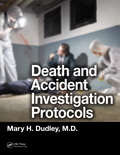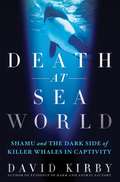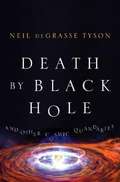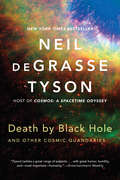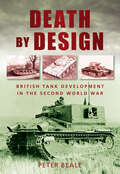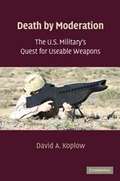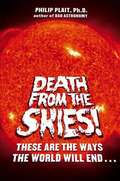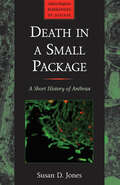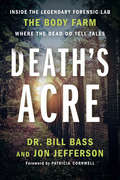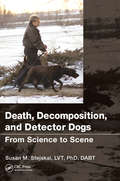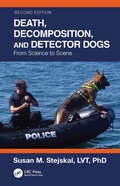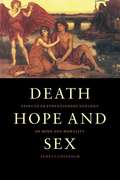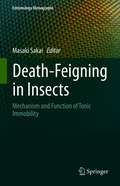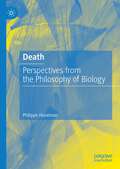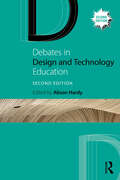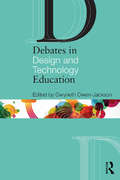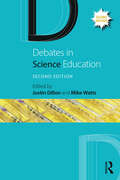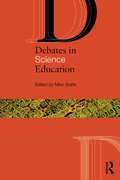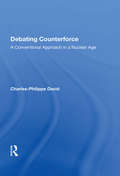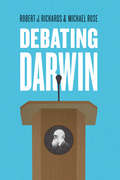- Table View
- List View
Death and Accident Investigation Protocols
by Mary H. DudleyThrough an examination and assessment of the body at a death scene, the medicolegal death investigator (MLDI) must be able to recognize circumstances that point to what manner of death occurred—be it natural causes, homicide, suicide, accident, or undetermined. A handy reference for use in the field and in the lab, Death and Accident Investigation Protocols provides 34 checklists and forms to help investigators make these determinations.Categories of death covered in this guide include: Aircraft and motor vehicle accident Alcohol- and drug-related Blunt- and sharp-force injury Drowning Electrocution, exposure, and fire Gunshot Hanging Hospital- and nursing home-related Infectious disease Natural causes Occupational exposure Poison and toxic substances Sexual assault Suicide Formatted as a convenient 8 ½ x 11 spiral-bound book, this manual helps investigators know what to look for, what questions to ask, and how to categorize the scene and the physical injuries. The forms in the book can either be downloaded, which allows for easy form modification. The text includes descriptive illustrations and diagrams associated with various categories of death. An essential tool for the busy investigator, the book facilitates the organization of information for a myriad of death scenarios.
Death and the Body in the Eighteenth-Century Novel
by Jolene ZigarovichDeath and the Body in the Eighteenth-Century Novel demonstrates that archives continually speak to the period’s rising funeral and mourning culture, as well as the increasing commodification of death and mourning typically associated with nineteenth-century practices. Drawing on a variety of historical discourses—such as wills, undertaking histories, medical treatises and textbooks, anatomical studies, philosophical treatises, and religious tracts and sermons—the book contributes to a fuller understanding of the history of death in the Enlightenment and its narrative transformation.Death and the Body in the Eighteenth-Century Novel not only offers new insights about the effect of a growing secularization and commodification of death on the culture and its productions, but also fills critical gaps in the history of death, using narrative as a distinct literary marker. As anatomists dissected, undertakers preserved, jewelers encased, and artists figured the corpse, so too the novelist portrayed bodily artifacts. Why are these morbid forms of materiality entombed in the novel? Jolene Zigarovich addresses this complex question by claiming that the body itself—its parts, or its preserved representation—functioned as secular memento, suggesting that preserved remains became symbols of individuality and subjectivity. To support the conception that in this period notions of self and knowing center upon theories of the tactile and material, the chapters are organized around sensory conceptions and bodily materials such as touch, preserved flesh, bowel, heart, wax, hair, and bone. Including numerous visual examples, the book also argues that the relic represents the slippage between corpse and treasure, sentimentality and materialism, and corporeal fetish and aesthetic accessory.Zigarovich’s analysis compels us to reassess the eighteenth-century response to and representation of the dead and dead-like body, and its material purpose and use in fiction. In a broader framework, Death and the Body in the Eighteenth-Century Novel also narrates a history of the novel that speaks to the cultural formation of modern individualism.
Death at Seaworld: Shamu and the Dark Side of Killer Whales in Captivity
by David KirbyFrom the New York Times bestselling author of Evidence of Harm and Animal Factory- a groundbreaking scientific thriller that exposes the dark side of SeaWorld, America's most beloved marine mammal park. Death at SeaWorld centers on the battle with the multimillion-dollar marine park industry over the controversial and even lethal ramifications of keeping killer whales in captivity. Following the story of marine biologist and animal advocate at the Humane Society of the US, Naomi Rose, Kirby tells the gripping story of the two-decade fight against PR-savvy SeaWorld, which came to a head with the tragic death of trainer Dawn Brancheau in 2010. Kirby puts that horrific animal-on-human attack in context. Brancheau's death was the most publicized among several brutal attacks that have occurred at Sea World and other marine mammal theme parks. Death at SeaWorld introduces real people taking part in this debate, from former trainers turned animal rights activists to the men and women that champion SeaWorld and the captivity of whales. In section two the orcas act out. And as the story progresses and orca attacks on trainers become increasingly violent, the warnings of Naomi Rose and other scientists fall on deaf ears, only to be realized with the death of Dawn Brancheau. Finally he covers the media backlash, the eyewitnesses who come forward to challenge SeaWorld's glossy image, and the groundbreaking OSHA case that challenges the very idea of keeping killer whales in captivity and may spell the end of having trainers in the water with the ocean's top predators.
Death by Black Hole: And Other Cosmic Quandaries
by Neil Degrasse TysonTouching on just about everything you want to know about the cosmos, this collection of essays by Tyson, an astrophysicist at the American Museum of Natural History and columnist for Natural History, explores topics from astral life to the movie industry's attempts to represent the night skies. In clear and witty prose, Tyson introduces the physics of black holes by describing what would happen if someone fell in, examines the needless friction between science and religion, and tells an ego-deflating story of Earth's progression from the center of the universe to a "small speck in the cosmos." Annotation ©2007 Book News, Inc., Portland, OR (booknews.com)
Death by Black Hole: And Other Cosmic Quandaries
by Neil deGrasse Tyson"[Tyson] tackles a great range of subjects…with great humor, humility, and—most important—humanity." —Entertainment Weekly Loyal readers of the monthly "Universe" essays in Natural History magazine have long recognized Neil deGrasse Tyson's talent for guiding them through the mysteries of the cosmos with clarity and enthusiasm. Bringing together more than forty of Tyson's favorite essays, Death by Black Hole explores a myriad of cosmic topics, from what it would be like to be inside a black hole to the movie industry's feeble efforts to get its night skies right. One of America's best-known astrophysicists, Tyson is a natural teacher who simplifies the complexities of astrophysics while sharing his infectious fascination for our universe.
Death by Design: British Tank Development in the Second World War
by Peter BealeAt the outbreak of war in 1939 British tank crews were ill-equipped, under trained and badly led. As a consequence the lives of hundreds of crewmen were wasted unnecessarily. This was due not only to the poor design and construction of British tanks, but also to the lack of thought and planning on the part of successive pre-war governments and the War Office. Death by Design explores how and why Britain went from leading the world in tank design at the end of the First World War to lagging far behind the design quality of Russian and German tanks in the Second World War. This book is a much-needed warning to governments and military planners: a nation must always be prepared to defend itself and ensure that its soldiers are equipped with the tools to do so.
Death by Moderation: The U. S. Military's Quest for Useable Weapons
by David A. KoplowThis book addresses an important but little-noticed phenomenon in the revolutionary world of military technology. Across a wide range of otherwise-unrelated weapons programs, the Pentagon is now pursuing arms that are deliberately crafted to be less powerful, less deadly, and less destructive than the systems they are designed to supplement or replace. This direction is historically anomalous; military forces generally pursue ever-bigger bangs, but the modern conditions of counter-insurgency warfare and military operations "other than war" (such as peacekeeping and humanitarian assistance) demand a military capable of modulated force. By providing a capacity to intervene deftly yet effectively, the new generations of "useable" weaponry should enable the U.S. military to accomplish its demanding missions in a manner consistent with legal obligations, public relations realities, and political constraints. Five case studies are provided, regarding precision-guided "smart bombs," low-yield nuclear weapons, self-neutralizing anti-personnel land mines, directed-energy anti-satellite weapons, and non-lethal weapons.
Death from the Skies! These Are the Ways the World Will End
by Plait PhilipA lively astronomy primer that uses cataclysmic scenarios to explain the universe's most fascinating events. According to astronomer Philip Plait, the universe is an apocalypse waiting to happen But how much do we really need to fear from things like black holes, gamma-ray bursts, and supernovae? And if we should be scared, is there anything we can do to save ourselves? With humor and wit, Plait details the myriad doomsday events that the cosmos could send our way to destroy our planet and life as we know it. This authoritative yet accessible study is the ultimate astronomy lesson. Combining fascinating?and often alarming?scenarios that seem plucked from science fiction with the latest research and opinions, Plait illustrates why outer space is not as remote as most people think. Each chapter explores a different phenomenon, explaining it in easy-to-understand terms, and considering how life on earth and the planet itself would be affected should the event come to pass. Rather than sensationalizing the information, Plait analyzes the probability of these catastrophes occurring in our lifetimes and what we can do to stop them. With its entertaining tone and enlightening explanation of unfathomable concepts, Death from the Skies! will appeal to science buffs and beginners alike. .
Death in a Small Package: A Short History of Anthrax (Johns Hopkins Biographies of Disease)
by Susan D. JonesA look at the historical development of the lethal disease and its relationship with humanity.A disease of soil, animals, and people, anthrax has threatened lives for at least two thousand years. Farmers have long recognized its lasting virulence, but in our time, anthrax has been associated with terrorism and warfare. What accounts for this frightening transformation? Death in a Small Package recounts how this ubiquitous agricultural disease came to be one of the deadliest and most feared biological weapons in the world.Bacillus anthracis is lethal. Animals killed by the disease are buried deep underground, where anthrax spores remain viable for decades or even centuries and, if accidentally disturbed, can cause new infections. But anthrax can be deliberately aerosolized and used to kill—as it was in the United States in 2001.Historian and veterinarian Susan D. Jones recounts the life story of anthrax through the biology of the bacillus; the political, economic, geographic, and scientific factors that affect anthrax prevalence; and the cultural beliefs about the disease that have shaped human responses to it. She explains how Bacillus anthracis became domesticated, discusses what researchers have learned from numerous outbreaks, and analyzes how the bacillus came to be weaponized and what this development means for the modern world.Jones compellingly narrates the biography of this frightfully hardy disease from the ancient world through the present day.“Death in a Small Package is interesting, well written, and accessible, presenting a worthwhile addition to the history of modern medicine and bacteriological science.” —Karen Brown, Isis
Death in a Small Package: A Short History of Anthrax (Johns Hopkins Biographies of Disease)
by Susan D. JonesA disease of soil, animals, and people, anthrax has threatened lives for at least two thousand years. Farmers have long recognized its lasting virulence, but in our time, anthrax has been associated with terrorism and warfare. What accounts for this frightening transformation? Death in a Small Package recounts how this ubiquitous agricultural disease came to be one of the deadliest and most feared biological weapons in the world.Bacillus anthracis is lethal. Animals killed by the disease are buried deep underground, where anthrax spores remain viable for decades or even centuries and, if accidentally disturbed, can cause new infections. But anthrax can be deliberately aerosolized and used to kill—as it was in the United States in 2001. Historian and veterinarian Susan D. Jones recounts the life story of anthrax through the biology of the bacillus; the political, economic, geographic, and scientific factors that affect anthrax prevalance; and the cultural beliefs about the disease that have shaped human responses to it. She explains how Bacillus anthracis became domesticated, discusses what researchers have learned from numerous outbreaks, and analyzes how the bacillus came to be weaponized and what this development means for the modern world.Jones compellingly narrates the biography of this frightfully hardy disease from the ancient world through the present day.
Death's Acre: Inside the Legendary Forensic Lab the Body Farm Where the Dead Do Tell Tales
by Jon Jefferson William BassDr. Bill Bass, one of the world's leading forensic anthropologists, gained international attention when he built a forensic lab like no other: The Body Farm. Now, this master scientist unlocks the gates of his lab to reveal his most intriguing cases-and to revisit the Lindbergh kidnapping and murder, fifty years after the fact.
Death, Decomposition, and Detector Dogs: From Science to Scene
by Susan M. StejskalDeath, Decomposition, and Detector Dogs: From Science to Scene is designed to help police investigators and Human Remains Detection K9 handlers understand the basics of forensic taphonomy (decomposition) and how to most effectively use a human remains detection (HRD) K9 as a locating tool. The book covers basic anatomy and the physiology of canine
Death, Decomposition, and Detector Dogs: From Science to Scene
by Susan M. StejskalDeath, Decomposition, and Detector Dogs: From Science to Scene, Second Edition is designed to help canine handlers, detectives, death investigators, crime scene personnel (including forensic laboratory personnel, technicians, and supervisors), and attorneys understand the science involved when utilizing human remains detector (HRD) canines as a locating tool. The book covers the basic anatomy and physiology of canine olfaction and the unique characteristics of their scenting ability that allows dogs to be trained to locate distinct odors. Using concise and clear explanations and photographs, the book reviews the science of forensic taphonomy. Factors that may affect the decomposition process are highlighted along with what the potential outcomes that may be encountered. The book examines how the odor of human remains is generated through various stages of decomposition and the manner in which environmental conditions in both land and water settings may affect that odor. Different types of background information that may help in determining possible search locations for missing individuals are included as well as assist the HRD canine handler in developing search plans are covered. Different tools and technologies that may be used in addition to an HRD canine team are included to help readers understand that are many ways to address searching for a decedent. Several case reports involving decedents, found in both land and water settings in addition to different weather conditions, are included to help the reader understand how the environment may have affected the condition of the decedent. This edition includes more case reports explaining how environmental factors were considered in HRD canine deployments in both land and water settings. Understanding which variables—and how such variables—can affect the state and condition of human remains, as well as dispersion of odor from human remains, will help canine handlers utilize their HRD canine more effectively as a locating tool. Death, Decomposition, and Detector Dogs, Second Edition will help HRD canine handlers and other law enforcement personnel be better prepared to meet the challenges of their jobs before, during, and after searches for the missing.
Death, Hope And Sex: Steps To An Evolutionary Ecology Of Mind And Morality
by James S. ChisholmBy showing how and why human nature is what it is, evolutionary theory can help us see better what we need to do to improve the human condition. Following evolutionary theory to its logical conclusion, Death, Hope and Sex uses life history theory and attachment theory to construct a model of human nature in which critical features are understood in terms of the development of alternative reproductive strategies contingent on environmental risk and uncertainty. James Chisholm examines the implications of this model for perspectives on concerns associated with human reproduction, including teen pregnancy, and young male violence. He thus develops new approaches for thorny issues such as the nature-nurture and mind-body dichotomies. Bridging the gap between the social and biological sciences, this far-reaching volume will be a source of inspiration, debate and discussion for all those interested in the evolution of human nature and the potential for an evolutionary humanism.
Death-Feigning in Insects: Mechanism and Function of Tonic Immobility (Entomology Monographs)
by Masaki SakaiThis book examines the mechanisms and functions of tonic immobility, the so-called death feigning behavior, or thanatosis, or animal hypnosis. The chapters cover the neurophysiological and experimental studies on insects, the functional significance of death-feigning, examination of the freezing and immobility behavior in insects through environment, physiology, genetics, and responses to ultrasound and vibration. It also covers tonic immobility and freezing behavior in fish from the perspective of vertebrates study.Tonic immobility is an interesting behavior that occurs reflexively in various animals under physical restraint by predators. The physiological mechanism of thanatosis was extensively investigated during 1960-1980. Researchers have proposed hypotheses to explain the mechanism underlying tonic immobility in vertebrates; local inhibition of the central nervous system, acceleration of the limbic system, abnormal control of the autonomic nervous system. On the other hand, the peripheral and central mechanisms of tonic immobility were intensely investigated at a behavioral and a neuronal level in stick insects and crickets. In the 1970s, behavioral ecology has shed light on the aspect of an ultimate factor for tonic immobility. Ethologists and ecologists challenged this matter in the laboratory and natural habitats, and have collected evidence for its functional roles using mainly insects such as beetles, moths, locusts. More recently, studies of tonic immobility in humans are drawing attention, as clinicians are trying to explain the defencelessness of rape victims from the viewpoint of animal hypnosis.This timely publication provides an understanding of the past and present research of the mechanisms and functions of tonic immobility. This book is intended for researchers and undergraduate/ graduate students in the field of zoology including physiology, ethology, ecology, and human behavior. It will also appeal to the public audience who has an interest in animal behavior, including human behavior.
Death: Perspectives from the Philosophy of Biology
by Philippe HunemanThis book addresses several key issues in the biological study of death with the intent of capturing their genealogy, the assumptions and presuppositions they make, and the way that they open specific new research avenues. The book is divided into two sections: the first considers physiology and the second evolutionary biology. In the first part, Huneman reconstructs a conceptual genealogy of experimental physiology based on an in-depth analysis of Bichat's investigations of death processes. In the second part he explains that biologists in the late 1950s put forth a research framework that evolutionarily accounts for death in terms of either an effect of the weakness of natural selection or a by-product of natural selection for early reproduction. He illustrates how the biology of death is a central field and that studying it provides insight into the way that the epistemic structure of this knowledge has been constituted, persists until now, and may conflict with some traditional philosophical ideas.
Debate Dynamics: How Controversy Improves Our Beliefs
by Gregor BetzIs critical argumentation an effective way to overcome disagreement? And does the exchange of arguments bring opponents in a controversy closer to the truth? This study provides a new perspective on these pivotal questions. By means of multi-agent simulations, it investigates the truth and consensus-conduciveness of controversial debates. The book brings together research in formal epistemology and argumentation theory. Aside from its consequences for discursive practice, the work may have important implications for philosophy of science and the way we construe scientific rationality as well.
Debate Dynamics: How Controversy Improves Our Beliefs (Synthese Library #357)
by Gregor BetzIs critical argumentation an effective way to overcome disagreement? And does the exchange of arguments bring opponents in a controversy closer to the truth? This study provides a new perspective on these pivotal questions. By means of multi-agent simulations, it investigates the truth and consensus-conduciveness of controversial debates. The book brings together research in formal epistemology and argumentation theory. Aside from its consequences for discursive practice, the work may have important implications for philosophy of science and the way we construe scientific rationality as well.
Debates in Design and Technology Education (Debates in Subject Teaching)
by Alison HardyDesign and technology is a relatively new subject compared to more traditional subjects, and during its brief existence, it has garnered widespread debate in schools. This book aims to explore some of these debates and challenges the reader with new perspectives about the subject by presenting and questioning arguments about the purpose, content and place of design and technology in the school curriculum. It will encourage the reader to critically reflect on their own beliefs and practices to reach informed judgements and perspectives that will affect how they teach and think about design and technology. Exploring the major issues that design and technology teachers encounter in their professional lives as well as introducing new topics they may never have considered before, this comprehensive second edition has been fully updated with 16 chapters focusing on emerging and enduring debates: How do we do race in design and technology? What’s so special about design and technology anyway? What is design cognition in design and technology classrooms? What is the potential of feedback in the creative processes of a design and technology classroom? Does food fit in design and technology? What is the role of making in design and technology? With its combination of expert opinion and fresh insight, Debates in Design and Technology Education is the ideal companion for any student or practising teacher engaged in initial training, continuing professional development or master’s-level study.
Debates in Design and Technology Education (Debates in Subject Teaching)
by Gwyneth Owen-JacksonDesign and Technology has long held a controversial place on the school curriculum, with some arguing that it shouldn’t be there at all. This book presents and questions considered arguments and judgements, and explores the major issues that all D&T teachers encounter in their daily professional lives. In exploring some of the key debates, it encourages critical reflection and aims to stimulate both novice and experienced teachers to think more deeply about their practice, and link research and evidence to what they have observed in schools. Written by expert design and technology education professionals, chapters tackle established and contemporary issues, enabling you to reach informed judgements and argue your point of view with deeper theoretical knowledge and understanding. Debates covered include: What is the purpose of design and technology? Is it a vocational or academic subject? What is the place of design and technology within the STEM agenda? What knowledge and skills do teachers really need? What does the design and technology gender divide mean for schools and pupils? Is it a ‘creative’ subject? What is the future for design and technology? With its combination of expert opinion and fresh insight, Debates in Design and Technology Education is the ideal companion for any student or practising teacher engaged in initial training, continuing professional development or Masters level study.
Debates in Science Education (Debates in Subject Teaching)
by Justin Dillon Mike WattsThis fully revised second edition of Debates in Science Education explores the major issues that science teachers encounter in teaching their subject, encouraging the reader to make their own informed judgements and argue their point of view with deeper theoretical knowledge and understanding. Brand new chapters written by a team of international experts provide fresh insight into topics of central importance when teaching science. Written to aid and inspire beginning teachers, current teachers and established subject leaders, these focused chapters are essential to anyone wishing to deepen their understanding of salient issues within school science education, including: STEAM education; sustainability and climate change; science and sensitive issues; equity and diversity; science and sex education; science and religion; science and pedagogy (including science inquiry); transition from primary to secondary school. Encouraging critical reflection and aiming to stimulate both novice and experienced teachers, this book is a valuable resource for any student or practicing teacher and particularly those engaged in continuing professional development or Master’s level study.
Debates in Science Education (Debates in Subject Teaching)
by Mike WattsWhat are the key debates in science teaching and learning today? Debates in Science Education explores the major issues all science teachers encounter in their daily professional lives. It encourages critical reflection and aims to stimulate both novice and experienced teachers to think more deeply about their practice, and link research and evidence to what they have observed in schools. Written by expert science educators, chapters tackle established and contemporary issues enabling you to reach informed judgements and argue your point of view with deeper theoretical knowledge and understanding. Each chapter is supported and extended by carefully selected further reading and reflective questions. Key debates include: the impact of policy on science education; transition from primary to secondary school; getting right the secondary science curriculum; girls in science; sex education and science; school science and technology; language and communication in the classroom; world science, local science. With its combination of expert opinion and fresh insight, Debates in Science Education is the ideal companion for any student or practising teacher engaged in initial training, continuing professional development and Masters level study.
Debating Counterforce: A Conventional Approach In A Nuclear Age
by Charles-Philippe DavidSince the U.S. presidential elections of 1980, debate has intensified between those who believe that nuclear weapons can only deter a war not intended to be fought and those who see nuclear weapons as an advancement in weaponry that allows for the waging and winning of a nuclear war. At the focal point of this debate is the rise of the “counterforc
Debating Darwin: From Darwin To Dna
by Robert J. Richards Michael RuseCharles Darwin is easily the most famous scientist of the modern age, and his theory of evolution is constantly referenced in many contexts by scientists and nonscientists alike. And yet, despite how frequently his ideas are evoked, there remains a surprising amount we don't know about the father of modern evolutionary thinking, his intellectual roots, and the science he produced. Debating Darwin seeks to change that, bringing together two leading Darwin scholars--Robert J. Richards and Michael Ruse--to engage in a spirited and insightful dialogue, offering their interpretations of Darwin and their critiques of each other's thinking. Examining key disagreements about Darwin that continue to confound even committed Darwinists, Richards and Ruse offer divergent views on the origins and nature of Darwin and his ideas. Ruse argues that Darwin was quintessentially British and that the roots of his thought can be traced back to the eighteenth century, particularly to the Industrial Revolution and thinkers such as Adam Smith and Thomas Robert Malthus. Ruse argues that when these influences are appreciated, we can see how Darwin's work in biology is an extension of their theories. In contrast, Richards presents Darwin as a more cosmopolitan, self-educated man, influenced as much by French and particularly German thinkers. Above all, argues Richards, it was Alexander von Humboldt who both inspired Darwin and gave him the conceptual tools that he needed to find and formulate his evolutionary hypotheses. Together, the authors show how the reverberations of the contrasting views on Darwin's influences can be felt in theories about the nature of natural selection, the role of metaphor in science, and the place of God in Darwin's thought. Revealing how much there still is to investigate and interrogate about Darwin's ideas, Debating Darwin contributes to our understanding of evolution itself. The book concludes with a jointly authored chapter that brings this debate into the present, focusing on human evolution, consciousness, religion, and morality. This will be powerful, essential reading for anyone seeking a comprehensive understanding of modern-day evolutionary science and philosophy.
Debating the Faith: Religion and Letter Writing in Great Britain, 1550-1800
by Anne Dunan-Page Clotilde PrunierThe first book to address the role of correspondence in the study of religion, Debating the Faith: Religion and Letter Writing in Great Britain, 1550-1800 shows how letters shaped religious debate in early-modern and Enlightenment Britain, and discusses the materiality of the letters as well as questions of form and genre. Particular attention is paid to the contexts in which letters were composed, sent, read, distributed, and then destroyed, copied or printed, in periods of religious tolerance or persecution. The opening section, 'Protestant identities', examines the importance of letters in the shaping of British protestantism from the underground correspondence of Protestant martyrs in the reign of Mary I to dissident letters after the Act of Toleration. 'Representations of British Catholicism', explores the way English, Irish and Scottish Catholics, whether in exile or at home, defined their faith, established epistolary networks, and addressed political and religious allegiances in the face of adversity. The last part, 'Religion, science and philosophy', focuses on the religious content of correspondence between natural scientists and philosophers.
